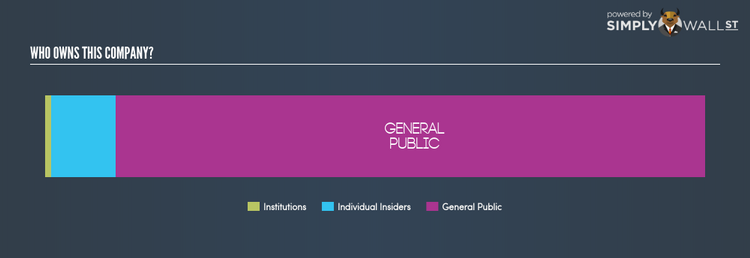Why NioCorp Developments Ltd’s (TSE:NB) Investor Composition Impacts Your Returns

In this article, I’m going to take a look at NioCorp Developments Ltd’s (TSX:NB) latest ownership structure, a non-fundamental factor which is important, but remains a less discussed subject among investors. Ownership structure of a company has been found to affect share performance over time. Differences in ownership structure of companies can have a profound effect on how management’s incentives are aligned with shareholder returns, which is why we’ll take a moment to analyse NB’s shareholder registry. All data provided is as of the most recent financial year end.
View our latest analysis for NioCorp Developments
Institutional Ownership
Institutional investors are one of the largest group of market participants and their buy-sell decisions on a company’s stock can significantly impact prices, more so, when there are relatively small amounts of shares available on the market to trade. With an institutional ownership of 1.08%, NB doesn’t seem too exposed to higher volatility resulting from institutional trading. Apart from low institutional ownership, another indicator of NB’s low popularity is the fact that the company is only covered by 1 analyst. Less covered stocks like NB used to feature in legendary investor Peter Lynch’s portfolio, which would later be bought up by fast-following institutions as the stock gained more popularity.
Insider Ownership
I find insiders are another important group of stakeholders, who are directly involved in making key decisions related to the use of capital. In essence, insider ownership is more about the alignment of shareholders’ interests with the management. NB insiders are also influential stakeholders with 9.72% ownership in the company. This level of stake with insiders indicate highly aligned interests of shareholders and company executives. I will also like to check what insiders have been doing recently with their holdings. insider buying may be a sign of upbeat future expectations, however, selling doesn’t necessarily mean the opposite as insiders may be motivated by their personal financial needs.
General Public Ownership
A substantial ownership of 89.21% in NB is held by the general public. This size of ownership gives retail investors collective power in deciding on major policy decisions such as executive compensation, appointment of directors and acquisitions of businesses. This level of ownership gives retail investors the power to sway key policy decisions such as board composition, executive compensation, and potential acquisitions. This is a positive sign for an investor who wants to be involved in key decision-making of the company.
What this means for you:
Institutional ownership level and composition in NB is not high nor active enough to significantly impact its investment thesis. However, ownership structure should not be the only determining factor when you’re building an investment thesis for NB. Rather, you should be examining fundamental factors such as the intrinsic valuation, which is a key driver of NioCorp Developments’s share price. I highly recommend you to complete your research by taking a look at the following:
1. Financial Health: Is NB’s operations financially sustainable? Balance sheets can be hard to analyze, which is why we’ve done it for you. Check out our financial health checks here.
2. Past Track Record: Has NB been consistently performing well irrespective of the ups and downs in the market? Go into more detail in the past performance analysis and take a look at the free visual representations of NB’s historicals for more clarity.
3. Other High-Performing Stocks: Are there other stocks that provide better prospects with proven track records? Explore our free list of these great stocks here.
NB: Figures in this article are calculated using data from the last twelve months, which refer to the 12-month period ending on the last date of the month the financial statement is dated. This may not be consistent with full year annual report figures.
To help readers see pass the short term volatility of the financial market, we aim to bring you a long-term focused research analysis purely driven by fundamental data. Note that our analysis does not factor in the latest price sensitive company announcements.
The author is an independent contributor and at the time of publication had no position in the stocks mentioned.

